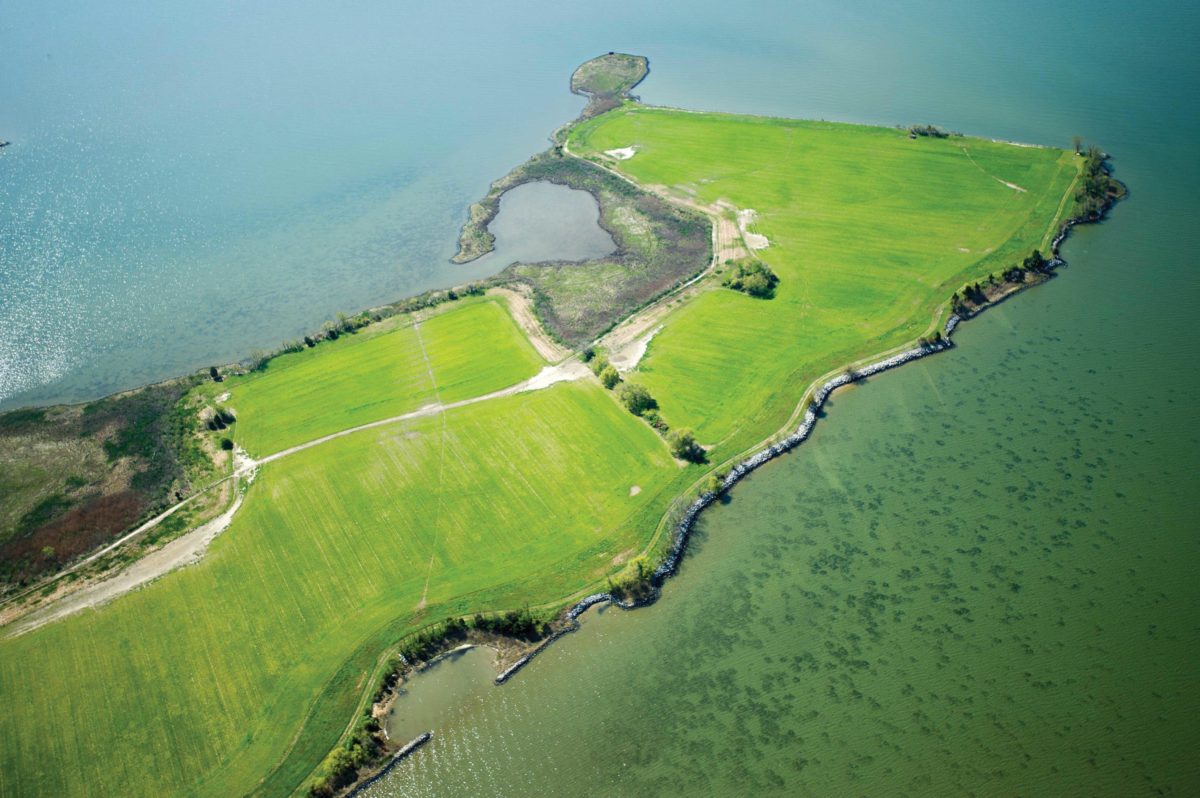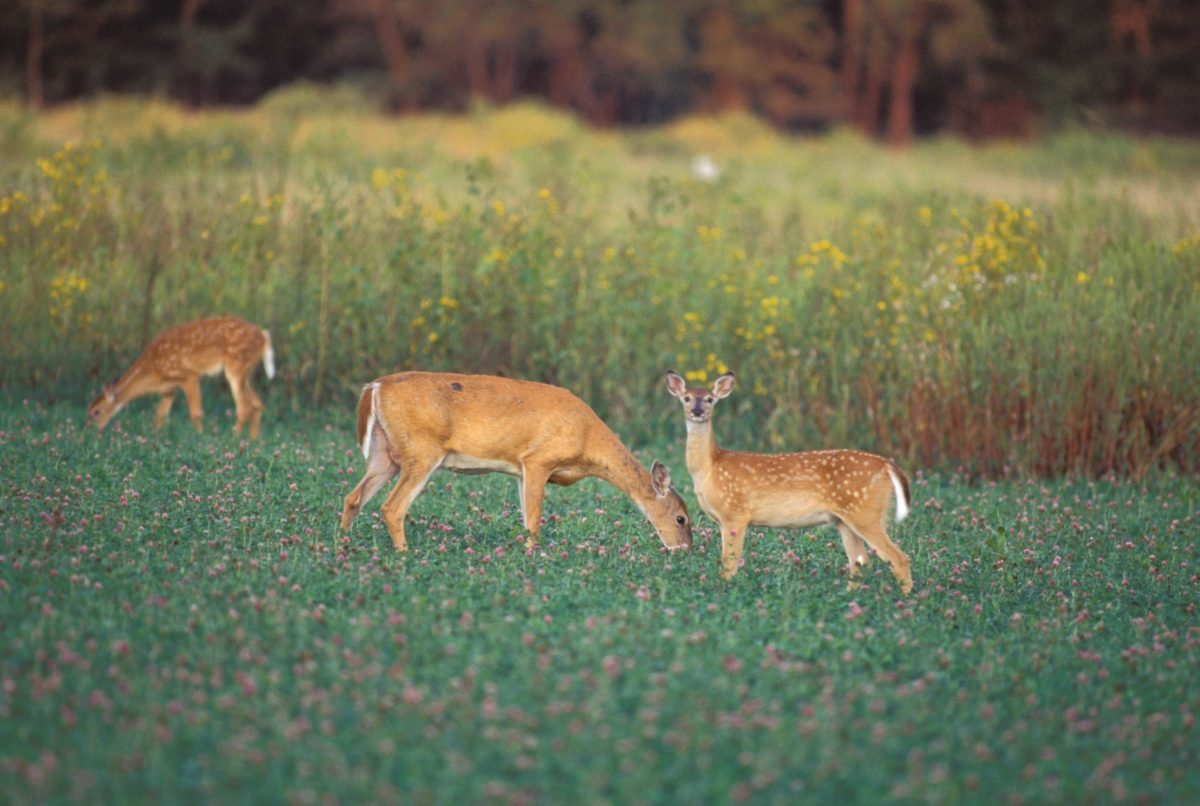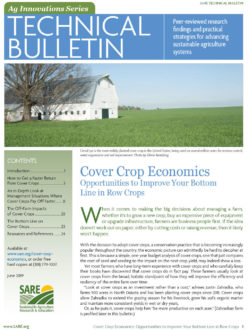
Researchers have found that cover crops are very effective at protecting water quality. Here, cover crops are growing in fields along the Chesapeake Bay. Photo by Edwin Remsberg
The real-world effect of farm activities extends well beyond the farm gate. Collectively, the activities of farming operations affect not only regional ecosystems but also rural communities and society as a whole. As part of a holistic review of cover crop economics, it is worth noting some of the ways that cover crops can influence off-farm economics, especially in a consumer culture where buyers increasingly want to know the origin and environmental impact of the products they buy.
Water Quality
Everyone wants clean water, whether it is safe drinking water or clear lakes and rivers. Unfortunately, nitrates and phosphorus have become a water quality issue in many areas due to a variety of nonpoint sources. Hypoxic (low oxygen) zones in the Chesapeake Bay, Gulf of Mexico and elsewhere are caused by the presence of too many nutrients like nitrogen and phosphorus. In these areas, fish and shellfish cannot survive due to a lack of oxygen, and as a result local fishing industries suffer millions of dollars of losses per year. Concern over these hypoxic zones has caused policymakers and farmers to work to reduce nitrogen and phosphorus loads to U.S. waterways, including the Mississippi River Basin. Agriculture is by no means the only source of nutrients to the Gulf and other waterways, but it is a significant source, which means that producers have an opportunity to reduce pollutant loads and improve water quality.
Cover crops represent one of the best ways farmers can improve water quality while also contributing to the profitability of their operation. Cover crops reduce nutrient losses by holding the soil in place and taking up excess nitrogen from the soil during winter months. A review of numerous research studies showed that they provide a median reduction of 48% in nitrogen leaching from farms [17]. In addition, cover crops have shown to reduce soil erosion, on average reducing soil loss by 20.8 tons per acre compared to conventional fields [18]. Cover crops also promote rainfall infiltration, which increases water flow into the soil profile by more than six-fold in some systems. The more water that enters the soil profile, the less runoff that flows over the field and the less total risk of erosion. Eroded soil particles carry sediment with them into waterways.
Closer to home for Iowa farmers, the state of Iowa is increasingly concerned about the human health consequences of nutrient water pollution and is actively looking for solutions. Some utilities in the state have invested over $1.6 million in recent years to improve their nitrate removal systems due to high levels [15].
Infrastructure Costs
When cover crops improve rainfall infiltration and reduce soil erosion, the potential benefits extend beyond curbing pollution. It is possible that by reducing sediment loads to waterways, cover crops may actually reduce how often waterways must be dredged, thus saving taxpayer dollars. And, with increasingly heavy rainfalls occurring in recent years, the promise of better infiltration means that cover-cropped farmland could reduce flood risk and mitigate the costs associated with post-flood cleanup like repairing damaged bridges. A recent report by the Union of Concerned Scientists discussed how building healthy soils could reduce runoff and flood frequency by 20% in flood years [1]. Using cover crops and no-till over the majority of a watershed to improve rainfall infiltration can also lessen the need for costly work to raise dam heights in order to deal with more rain.
Carbon

Carbon dioxide concentrations in the Earth’s atmosphere have led state and federal governments across the globe to consider policy measures aimed at pulling down carbon and storing it, with the ultimate goal of mitigating climate change.
The soil is one of the Earth’s largest carbon reservoirs, and cover crops are one practice that actively promotes carbon sequestration. A literature review found that cover crops can sequester a median value of 0.58 tons of carbon per acre [16]. The societal benefits of carbon sequestration can be realized in reduced costs associated with a changing climate; the direct economic value of a ton of carbon was listed as $15.10 in the state of California in 2018 [3]. It has been suggested that farmers should be compensated at $16 per acre per year for sequestering soil carbon and for provisioning other ecosystem service benefits to society [10].
Biodiversity
Wild insects, birds and mammals can benefit from cover crops, too. Groundcover increases the available forage and habitat for these animals, especially during seasonal changes when birds are migrating and when winter food may be tough to find. For example, an Illinois research project documented more waterfowl and songbirds where cover crops were used compared to fields without covers [19]. For pollinators, cover crops provide forage, which helps keep these beneficial insects healthy and fed.
Increased biodiversity may also benefit state tourism by allowing better hunting opportunities for birds and deer during the non-growing season.
Other Potential Societal Savings from Cover Crops
The biggest single outlay by the federal government in support of crop farms is for crop insurance. From 2007 to 2016, the Congressional Research Service (CRS) calculated that the net cost of federal crop insurance was $72 billion. Looking ahead, CRS projects that federal crop insurance will cost $77 billion from 2018 to 2027. Cover crops are certainly not a replacement for the federal crop insurance program, but there is evidence that widespread use of cover crops over multiple years can reduce some of the costs of crop insurance for taxpayers. This is because cover crops improve soil resiliency, which helps reduce yield losses in drought years.
